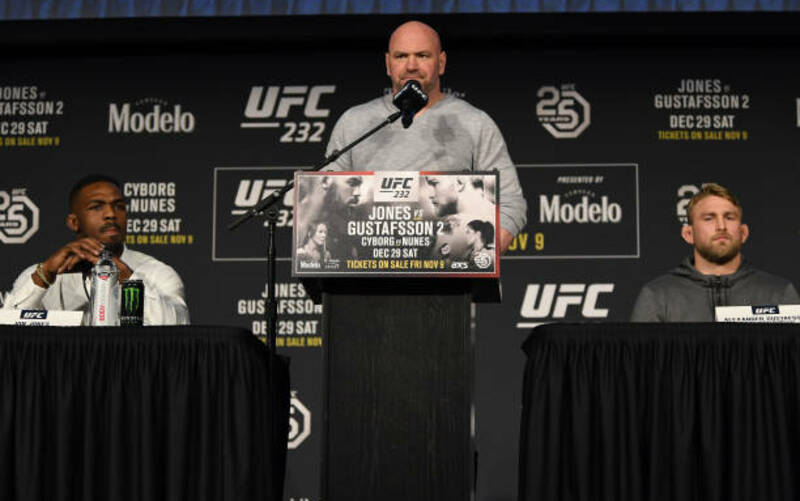The UFC’s decision to relocate UFC 232 is certainly driven by money, but for different reasons than many think.
The main event for UFC 232 at the T-Mobile Arena was thrown into jeopardy Sunday. An announcement stated a ‘very small amount‘ of the steroid commonly known as turinabol was found in headliner Jon Jones’ system. His failed test stemmed from an out of competition drug test on December 9, 2018. In response, the UFC and USADA stated that the failed test was a result of previous ingestion. Thusly falling under the purview of Jones’ 2017 suspension for the same drug.
READ MORE: A Definitive Guide to MMA and the USADA
The Nevada State Athletic Commission (NSAC) refused to sanction a fight for ‘Bones’ without a hearing taking place. On the other hand, the neighboring California State Athletic Commission (CSAC), agreed to license the former 205 lbs. champion. The CSAC allowed him to fight when the UFC sees fit so long as he consents to additional testing under the Voluntary Anti-Doping Agency (VADA).
UFC 232 Venue Change
So, of course, the reasonable thing to do is to relocate the entire card on a week’s notice
Yes, UFC 232 moved from Las Vegas, Nevada, to Los Angeles, California. The UFC did so in order to save the headlining light heavyweight title showdown. Fans became aware via various MMA news outlets on social media and by an ESPN SportsCenter update featuring UFC President Dana White and Vice President of Athlete Health and Performance Jeff Novitzky.
The UFC is no stranger to shuffling things around due to issues with Jones. Despite this, relocating a show to a different city in seven days’ time has consequences. The impact of the decision was already seen throughout the MMA community. Ticket holders raged over the venue change. Multiple fighters lamented the decrease of their paycheck due to California state taxes.
USADA’s waning credibility, the UFC’s relationship with its fans, and UFC 232’s overall financial success are all taking a hit as a result of the abrupt move.
A Tough Business Decision
So why not just pull Jones from the card? A super fight between Cris “Cyborg” Justino and Amanda Nunes for the women’s featherweight championship could easily be bumped up to a headliner. While the rest of the bouts planned for UFC 232 are nothing to scoff at. Why risk the ire of loyal fans, fighters, and NSAC officials in order to save one fight featuring a two-time doping offender?
Because Jon Jones is too important to the company’s long-term bottom line—and the UFC has a massive amount of debt to pay off.
It’s true. Despite various statements from Dana White about how Jones would never headline a pay-per-view again. How he was the biggest waste of talent in all of sports. The fact of the matter is “Bones” can sell the UFC product. The last six UFC events that Jon Jones has headlined are all estimated to have cleared 300,000 PPV buys. With his two bouts against Daniel Cormier being pegged closer to the 800,000 range. In an age where superstars are increasingly harder to find and pay-per-view sales are declining across the board. Jones has the potential to help bolster the UFC’s annual revenue if he can become a champion again.
The Financing Behind the UFC Sale
The UFC may very well need that boost, the sale of the company for $4 Billion to Endeavor back in 2016 may have been a historic one. Yet, it came with a slew of financial obligations and debt collectors. Goldman Sachs Groups, Inc. financed a whopping $1.825 billion of debt in the transaction. It’s estimated that the yearly interest on that figure alone is $137 million. That means the UFC has to generate at least that much in annual profit before it begins to pay down the actual debt it owes from the sale.
As for how that figure compares to the company’s previous earnings, it was publicly disclosed that from July 1, 2015, to June 30, 2016, the UFC reported an EBITDA (Earnings Before Interest, Tax, Depreciation, and Amortization) of $142 million—only $5 million more than the projected interest payment.
This fact was not lost on regulatory bodies either. The U.S. Federal Reserve Bank went so far as to issue a warning to Goldman Sachs during the sale. They stated its concern over accounting adjustments the firm used to more than double the UFC’s future cash flow projections to an estimated annual EBITDA of $298 million. While the altered forecasts were based on continued growth and a new cost-cutting strategy the UFC planned to implement (I’m looking at you, male flyweight division). The debt owed by the organization without those changes would have been roughly 13 times that of its EBITDA, making it an extremely risky investment.
Planning For the Future
The modified projections, however, are not completely unrealistic. The UFC’s new broadcast media rights deal with ESPN for $1.5 billion over five years is a $140 million per year increase from the promotion’s arrangement with FOX. If the UFC has also taken steps to cut costs internally, which it appears they have, an estimated yearly EBITDA of $298 million isn’t so far out of reach. Providing the company continues to grow and maintain its other revenue sources. That figure is a reasonable target for the promotion to hit.
But continued growth is something the UFC struggles with currently. With the exception of UFC 229, the biggest event in company history, no other UFC pay-per-view has broken 1 million buys in the past two years. In fact, outside of UFC 214 and UFC 217, no event in that time frame has surpassed the once common 400,000 buy mark. A troubling sign with pay-per-view supposedly making up 35 percent of the organization’s revenue stream.
Cost of Doing Business
Given all of the issues at play, the UFC views the backlash for moving UFC 232 to California as a necessary cost of doing business. The ESPN deal won’t kick in until January. All the while UFC 229 buoyed the organization during an otherwise lackluster 2017 and 2018. A successful end of the year event would help hedge against any further revenue decline from pay-per-view going the way of the Dodo. If Jones manages to win on Saturday, there’s also little doubt it would set up an even more lucrative fight for him and the UFC in the future. Providing he manages to stay eligible to compete.
Are the fans who bought tickets, booked flights, and planned their Las Vegas New Year’s trip being treated fairly in this situation? Are the fighters who have to pick up and move to a new location during weight cutting because of one repeat offender getting a good deal? Will the UFC’s arrangement with USADA have any credibility whatsoever moving forward?
No, not at all, and I highly doubt it.
But such is the cost of business, and the UFC knows that while there will be outrage over their last-minute antics, most people will still pay to watch the sport and fighters they love—even if they get screwed over in the process.



